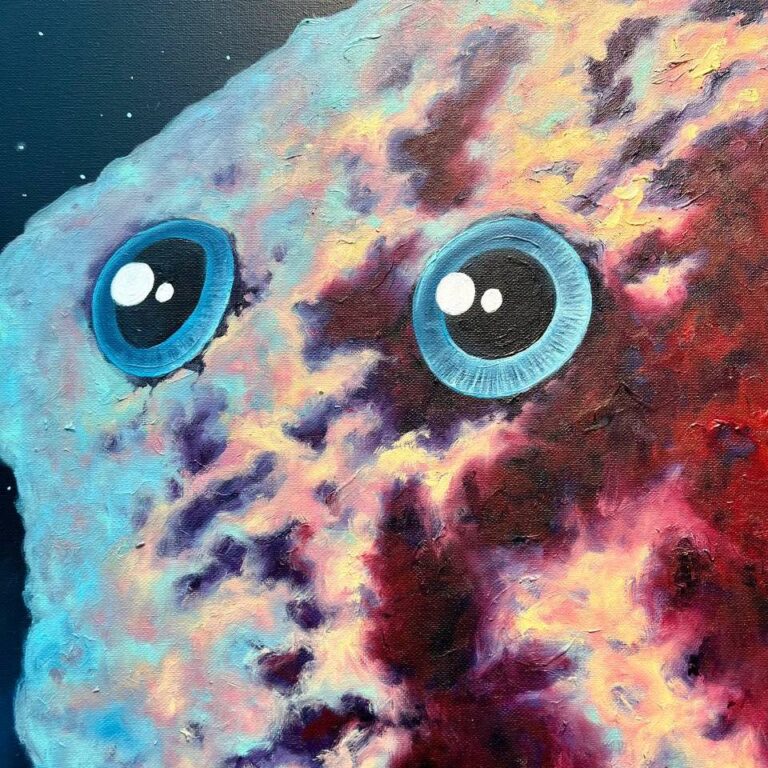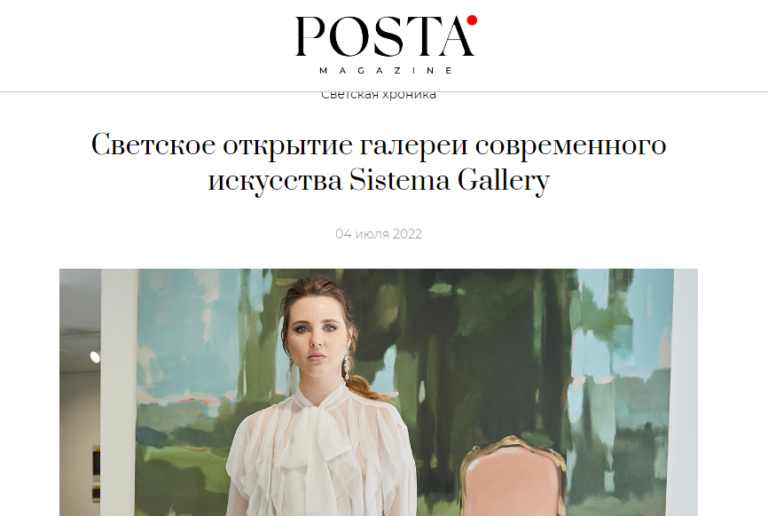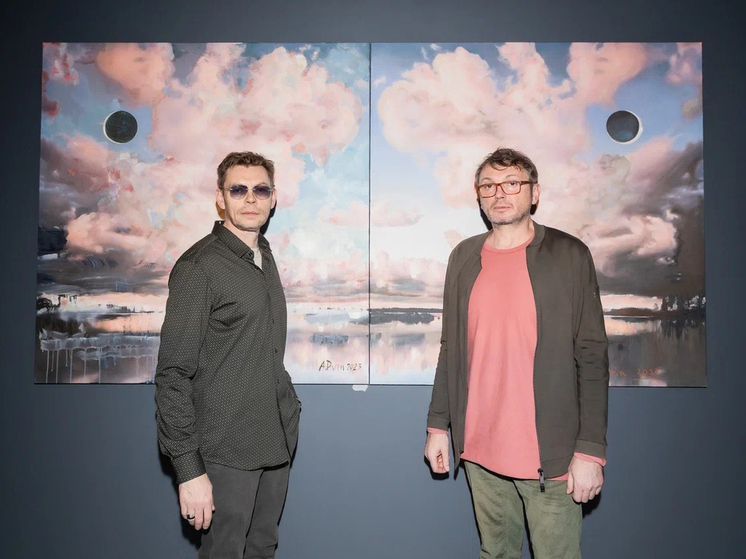“I WANT TO WORK IN INFINITE SPACE WITH BEAUTIFUL COSMIC OBJECTS”
In September, two exhibitions by Rostan Tavasiev – “Asteroids and Comets” and “Planetary Nebulae” – will open in the new SISTEMA GALLERY exhibition space. These are part of a larger project called “Catalog of Artworks in Outer Space”, which the artist, who became famous for his “begemotopis” – the use of plush toys in installations and paintings – has been engaged in for the past decade.
Rostan, your grandfather was the Soviet sculptor Soslanbek Tavasiev (1894-1974), the author of the legendary monument to Salavat Yulaev in Ufa. Why did neither your father nor you follow in his footsteps?
As Vladimir Semyonovich Vysotsky sang, “go your own way”. Each of us went our own way. My grandfather created majestic monuments, my father painted silk, I am exploring space. Since each of my ancestors reached a certain degree of perfection in their activities, it has always seemed pointless and unsporting to me to try to repeat their choices and their feats. We are indeed very different, as different as possible. And I think this is fine: we do not cast shadows on each other, no one overshadows anyone.
You didn’t go straight into contemporary art, did you? You studied to be a jeweler…
Yes, after school my parents sent me, a fool, to study at a jewelry vocational school, reasonably believing that it was a more reliable profession than that of an artist. And in general, I spent a useful time there – I developed diligence and fine motor skills. I got a generalist diploma and did not work a single minute in my specialty.
You told me that once you had an epiphany that you were an artist. And when did that happen?
Yes, no matter how hard my parents tried to protect me from this slippery slope, nothing helped. One day – in winter, I remember this moment very well – I’m sitting drawing and suddenly I feel that I’m an artist. Not that I would be an artist someday, but right here and now I was one. I was about 17 years old. And immediately after this epiphany, problems arose: I immediately felt that I lacked the knowledge and skills to fully do what I wanted to do. And I started to learn with joy and an incredible, completely uncharacteristic of me until that moment. It used to be boring to study, and I sabotaged education as much as I could, but here, just like young Lomonosov with a wagon, I went to Stroganovka. I worked as a laboratory assistant for two years to get in. In Stroganovka there was a lot of interesting things: descriptive geometry, art history, painting, drawing at a very high level. But the most valuable thing they taught me there was the algorithm for realizing ideas: how to go from conception to result, improving the idea along the way.
At the same time you studied at the Institute for Problems of Contemporary Art (IPCI). Why?
No particular reason, I don’t even have a diploma from the Institute for Problems of Contemporary Art. Out of the call of my heart. It was just very interesting there. If at Stroganovka we discussed how to draw, then at IPCI we discussed why to draw. And the most important thing was the people. For the first time in my life I met people close to me in spirit, in interests, in thoughts and views, who are concerned about the same problems as I am. People who love art as much as I do and want to understand it. Ira Korina brought me to IPSI. We studied together with Stas Shuripa and Lyudmila Konstantinova.
Then you became an artist at Aidan Salakhova Gallery. And how was that experience for you?
Oh, it was a wonderful experience! For example, the experience of selling my work for money for the first time had a great impact on me. Aidan looked at my drawings and liked them. She asked if I could reproduce two of them in acrylic on canvas. I confidently said that I could, although I had never held an acrylic before. The paintings turned out very well, and Aidan took them to the fair, to Art Moscow. And so I, worried, went to the installation, the day before the opening, to look at my works in the big hall, because before that I had only seen them in my room. As a student, I had no money at all at that moment, only for the subway one way, and I didn’t think about the return trip. When I got to the hall, Aidan handed me €700 – the advance payment for the work I had already bought. And then something changed in me. This change was even reflected on my face – Aidan and everyone at the booth started laughing. I didn’t understand at all what had happened. Why had I only spent all my money on my art up until that point, and now I was being paid for it? What had changed? What had I done differently? My experiences in that moment can be compared to those of a mouse in a red button experiment. If inquisitive scientists have programmed the button so that the appearance of candy after it is pressed is randomized, the mouse, like the young artist Rostand, is perplexed. How do you press the button so that the candy keeps appearing? I’ve been trying to understand this pattern for several years. It ended, as with the mouse, in an emotional crisis. But then came the cleansing realization that candy and the button are not really connected. You can relax and do what you love to do and get joy from the process – that’s the main, biggest “inner candy”.
So how did you come up with the “begemotopis”?
At first I was drawing plush toys on canvas. But then I thought, “Let them paint themselves!” I tried painting with the toys themselves. It turned out to be very convenient and fascinating. I still can’t stop, every now and then I pick up a bunny or a piglet and start drawing.
“Begemotopis” was a resounding success. It has been shown at exhibitions all over the world, and a sample of it is in the collection of the Tretyakov Gallery. How do you explain it?
The mechanism is very simple, which is why it is so effective. A toy is a powerful emotional stimulus, it activates the viewer’s imagination. The toy is eye-catching, “cute”, and the viewer’s imagination, fueled by empathy, begins to come up with all sorts of interpretations. Perception of art turns into a fascinating and enjoyable game. And it works especially strongly not while looking at a painting, but while creating it. I tried hippo painting as an educational program. Four classes, and anyone can master hippo painting. The toy removes the fear of the white canvas, helps to open up emotionally, to tell something truly personal and important. In general, hippo painting brings joy to people.
Tell us about the exhibitions you have opening at SISTEMA GALLERY. They are linked to your interest in the art of the future. Do you seriously want to predict what it will be like?
No, not at all. I’m not interested in the future at all. Only the present. I’ve been exploring the “imagined future” to figure out what to do now. An “imagined future” is a set of ideas and visions of the future described in science fiction. The term is taken from the story “Monday Begins on Saturday” by the Strugatsky brothers. I am very interested to see what place art can occupy in this world of imagined future in order to understand what to do now, in the “real present”. To understand what humanity dreams about and how they see art in their dreams. And what in the imagined future have you discovered that is interesting related to art? A dark, ringing void that shocked me. In science fiction, there’s hardly any art at all. Mankind, in its dream of the future, fails to see art. If there is any, it’s almost always art from the past. Ray Bradbury’s Mona Lisa, for example. Fiction does not give us artists the perspective of our profession. Realizing this, I got upset and started asking fiction writers, “How is it so? Where is the place of art in your works?” And they would reply, “Sorry, we don’t know how to make it up.” They can fantasize transportation, weapons, and medicine of the future, but they can’t imagine art. This injustice I decided to correct and created a project that allowed artists to come up with art for science fiction (www.imaginaryfutureart.com. – TANR). Then I thought: what would I myself like to see in science fiction about art? And I realized that I would really like to see a sci-fi series like Star Trek or Firefly, only about art. But no one was going to make such a show. So I decided to make it myself. I drew it like a diafilm. I posted it on YouTube, and to my surprise, it was very warmly received by the professional film community. The series “A Drop of Creacin” won an award at the Cannes Film Festival in the city of Kansk, and the magazine “The Art of Cinema” devoted a big article to it. But the most important thing is that, thanks to this series, I realized what I wanted to do. I managed to apply science fiction to my personal goals. Trying to understand the dreams of mankind, I accidentally dreamed a personal dream for myself. I realized that I really wanted to work in infinite space with beautiful space objects. And then, once again in my life, I realized that I lacked knowledge. So I went to the scientists with questions and I started to learn myself. Are you sure there’s a place for art in the future? I am sure that they will figure it out for themselves in the future. I repeat that I am interested in the present. But if we’re talking about art in space, you don’t even need to look at science fiction. If you remember ancient star atlases, they have all sorts of animal figures and ancient gods drawn on them, in addition to stars. At the same time asterisms and constellations do not closely resemble any Bears, Hounds and Perseus. It seems that people have a need to endow the cosmos with familiar imagery. And this need will not go away as the space is explored, but will only become stronger. Humans will definitely bring art into space. There is one more important point. Thinking about space exploration, in the same science fiction we see first of all the prospects of mining, colonization of new planets and heroic wars – either with each other or with sinister aliens. Space as the new Wild West, the Klondike. But is it worth getting off the couch for a repeat of all this? The main customers for space exploration and expansion are the military, and now the capitalists are pulling up a bit. They are the ones who set the goals and pay for the research. Scientists and engineers, using their knowledge and talents, work for their interests. We artists could at least try to participate in the process of space exploration. We are able to set our own interesting and unusual tasks before scientists and engineers, which may well yield interesting and unusual results. Because if we prepare in space only for war and robbery, we will only get them again.




